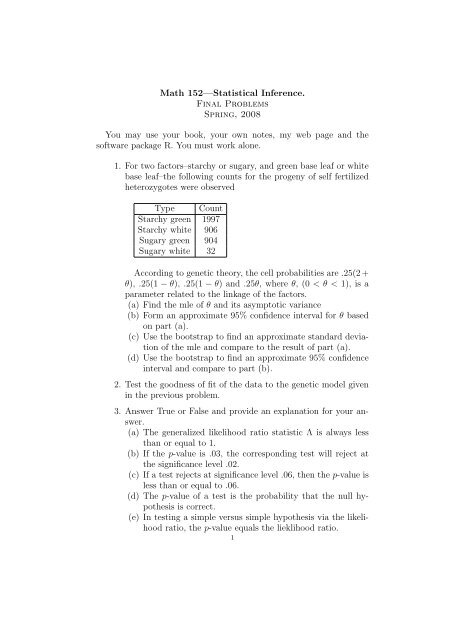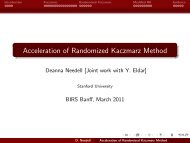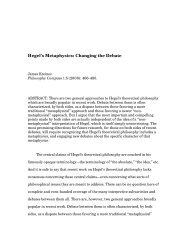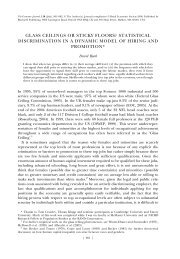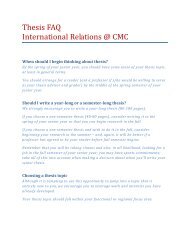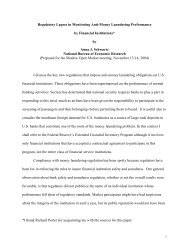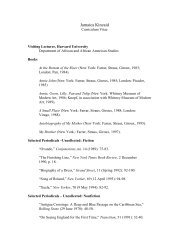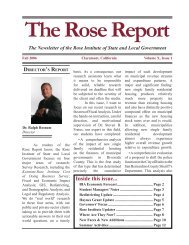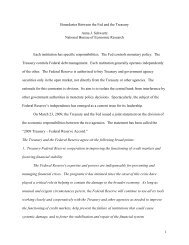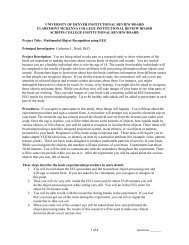Final Exam
Final Exam
Final Exam
You also want an ePaper? Increase the reach of your titles
YUMPU automatically turns print PDFs into web optimized ePapers that Google loves.
Math 152—Statistical Inference.<br />
<strong>Final</strong> Problems<br />
Spring, 2008<br />
You may use your book, your own notes, my web page and the<br />
software package R. You must work alone.<br />
1. For two factors–starchy or sugary, and green base leaf or white<br />
base leaf–the following counts for the progeny of self fertilized<br />
heterozygotes were observed<br />
Type Count<br />
Starchy green 1997<br />
Starchy white 906<br />
Sugary green 904<br />
Sugary white 32<br />
According to genetic theory, the cell probabilities are .25(2 +<br />
θ), .25(1 − θ), .25(1 − θ) and .25θ, where θ, (0 < θ < 1), is a<br />
parameter related to the linkage of the factors.<br />
(a) Find the mle of θ and its asymptotic variance<br />
(b) Form an approximate 95% confidence interval for θ based<br />
on part (a).<br />
(c) Use the bootstrap to find an approximate standard deviation<br />
of the mle and compare to the result of part (a).<br />
(d) Use the bootstrap to find an approximate 95% confidence<br />
interval and compare to part (b).<br />
2. Test the goodness of fit of the data to the genetic model given<br />
in the previous problem.<br />
3. Answer True or False and provide an explanation for your answer.<br />
(a) The generalized likelihood ratio statistic Λ is always less<br />
than or equal to 1.<br />
(b) If the p-value is .03, the corresponding test will reject at<br />
the significance level .02.<br />
(c) If a test rejects at significance level .06, then the p-value is<br />
less than or equal to .06.<br />
(d) The p-value of a test is the probability that the null hypothesis<br />
is correct.<br />
(e) In testing a simple versus simple hypothesis via the likelihood<br />
ratio, the p-value equals the lieklihood ratio.<br />
1
2<br />
(f) If a chi-square test statistic with 7 degrees of freedom has<br />
a value of 8.5, the p-value is less than .05.<br />
4. The intensity of light reflected by an object is measured. Suppose<br />
there are two types of possible objects, A and B.If the<br />
object is of type A, the measurement is normally distributed<br />
with mean 100 and standard deviation 25; if it is of type B, the<br />
measurement is normally distributed with mean 125 and standard<br />
deviation 25. A single measurement is taken with value<br />
X = 120.<br />
(a) What is the likelihood ratio?<br />
(b) If the prior probabilities of A and B are equal, what is the<br />
posterior probability that the item is of type B?<br />
(c) Suppose that a decision rule has been formulated that declares<br />
the object to be of type B if X > 125. What is the<br />
significance level associated with this rule?<br />
(d) What is the power of this test?<br />
(e) What is the p-value when X = 120?<br />
5. Suppose that a sample is taken from a symmetric distribution<br />
whose tails decrease more slowly than thos of the normal distribution.<br />
What would be the qualitative shape of a normal<br />
probability plot of this sample?<br />
6. Suppose that F is an exponential distribution with parameter<br />
λ = 1 and that G is exponential with parameter λ = 2. Sketch<br />
a Q-Q plot.<br />
7. Explain how the bootstrap could be used to approximate the<br />
sampling distribution of the MAD.<br />
8. Demographers often refer to the hazard function as the ”‘age<br />
specific mortality rate,” or death rate. Until recently, most researchers<br />
in the field of gerontology thought that a death rate<br />
increasing with age was a universal fact in the biological world.<br />
There has been heavy debate over whether there is a genetically<br />
programmed upper limit to lifespan. Using a facility in<br />
which sterelized medflies are bred to be released to fight medfly<br />
infestation in California, investigators bred more than a million<br />
medflies and recorded their pattern of mortality. The data file<br />
”medflies”, available at the course web page, contains the number<br />
of medflies alive from an initial population of 1, 203, 646 as<br />
a function of age in days. Using these data, estimate the age
specific mortality rate. Does it increase with age? What conclusions<br />
can you draw about the age specific mortality of the<br />
medflies?<br />
hints: One can approximate the derivative by 5 or 10 day<br />
difference quotients. The R command read.csv operates exactly<br />
as read.table.<br />
9. In their 1994 paper, “The bone density of female twins discordant<br />
for tobacco use” (N. Eng. J. Med., 330, 387-392), Hopper<br />
and Seeman studied the relationship between bone density and<br />
smoking among 41 pairs of middle-aged female twins. In each<br />
pair, one twin was a lighter smoker and one a heavier smoker,<br />
as measured by pack-years, the number of packages of cigarettes<br />
consumed in a year. Bone mineral density was measured<br />
at the lumbar spine, the femoral neck (hip), and the femoral<br />
shaft. As well as smoking, other variables, such as alcohol consumption<br />
and tea and coffee consumption, were recorded. The<br />
data are contained in the file “bonden” and documentation is<br />
in the file “bondendoc”. Use graphical methods and statistical<br />
tests (if possible) to compare bone densities of the heavy and<br />
light smoking twins. Do any other variables bear a relationship<br />
to bone density? After completing your analysis, compare<br />
your conclusions to those in the paper (which is available online<br />
through the Claremont Colleges Library web page). Your<br />
techniques will differ from those used by the investigators, so<br />
do your analysis before looking at the paper.<br />
10. The difference of the means of two normal distributions with<br />
equal variance is to be estimated by by sampling an equal number<br />
of observations from each distribution. If it were possible,<br />
would it be better to halve the standard deviations of the populations<br />
or double the sample sizes?<br />
11. Find the exact null distribution of the Mann-Whitney Statistic,<br />
U Y , in the case where m = 3 and n = 2.<br />
12. An experiment was done to test a method for reducing faults<br />
on telephone lines. Fourteen matched pairs of areas were used.<br />
The following table shows the fault rates for the control areas<br />
and the test areas:<br />
3
4<br />
Test Control<br />
676 88<br />
206 570<br />
230 605<br />
256 617<br />
280 653<br />
433 2913<br />
337 924<br />
466 286<br />
497 1098<br />
512 982<br />
794 2346<br />
428 321<br />
452 615<br />
512 519<br />
(a) Plot the differences versus the control rate and summarize<br />
what you see.<br />
(b) Calculate the mean difference, its standard deviation, and<br />
a confidence interval.<br />
(c) Calculate the median difference and a confidence interval<br />
and compare to the previous result.<br />
(d) Do you think it is more appropriate to use a t test or a nonparametric<br />
method to test whether the apparent difference<br />
between test and control could be due to chance?Why?<br />
Carry out both tests and compare.<br />
13. The media often present short reports of the results of experiments.<br />
To the critical reader or listener, such reports often raise<br />
more questions than they answer. Comment on possible pitfalls<br />
in the interpretation of each of the following.<br />
(a) Nonsmoking wives whose husbands smoke have a cancer<br />
rate twice that of wives whose husbands do not smoke.<br />
(b) A 2-year study in North Carolina found that 75% of all<br />
industrial accidents in the state happened to workers who<br />
had skipped breakfast.<br />
(c) A survey found that ose who drank a mderate amount of<br />
beer were healthier than those who totally abstained from<br />
alcohol.<br />
(d) A University of Wisconsin study showed that within 10<br />
years of the wedding, 38% of those who had lived together
efore marriage had split up, compared to 27% of those<br />
who had married without a “trial”’ period.<br />
5


